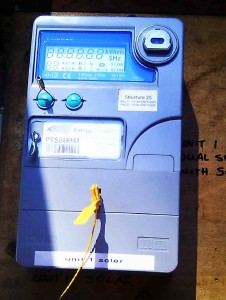Solar PV – Gross vs Net metering in Sydney

Modern Gross Meter, Sydney
Metering plays an important role in helping us to understand the performance of solar energy systems, and is usually best done by a specialist metering contractor. Often mistakenly called ‘Smart Meters’, the current practice is to install electronic (digital) meters that measure consumption across small intervals of time, such as 30 mins.
Two methods of recording grid connected solar energy production are available in Sydney. These are known as Gross & Net Metering. It should be noted that Gross Metering is only of benefit to existing customers connected under the old Solar Bonus Scheme. For all new connections, Net Metering will be the best option.
What is the Grid
The term grid is used to talk about the network of poles and wires in the street that supply us with electricity. When people talk about ‘exporting to the grid’ they mean sending electricity out to the wires in the street, so that other people can use the power.
What is a Grid Connected solar system?
Grid connection describes the arrangement where the energy produced by solar PV systems is sent to the electrical network by systems connected to it. The alternative would be a stand alone power system that charged batteries. Grid connected systems avoid the need to store energy in a battery, thereby reducing the cost of the system. In addition, you can draw electricity from the network if the power from your solar system is insufficient, at night for example.
What is a ‘Feed-in’ tariff ?
When electricity is sent from your solar system to the outside network, this is called exporting or ‘feeding into’ the grid. So, the price (or tariff) the electricity company pays you for each unit of electricity is called a feed in tariff. The pricing for your power usage is usually referred to as a consumption tariff. For more details, see our Feed-in Tariff Page
What is ‘Net’ metering?
Net metering describes a metering arrangement where only ‘excess’ solar electricity is sent to the electricity network (‘export’). Power is first sent to the appliances and lights in your house, and if excess remains, it is exported to the outside electricity network and its amount recorded. The saving reduces your bill in two ways: (1) results in a lower use of electricity from the network, and (2) small payment for the exported amount. Under this arrangement, cabling for the solar system does not need to go to the main meterbox, but can go to the nearest sub-board.
What is ‘Gross’ metering?
Gross metering describes a metering arrangement where all solar electricity generated is exported to the outside electricity network through an independent meter. You would continue to have a separate meter that records how you use power. Gross metering is considered a good way to encourage householders to invest in solar, because the amount received is very obvious, and it is possible to easily offer a premium rate to householders for solar production. Under this arrangement, cabling for the solar system must go to the main meterbox, or the location of the gross meter.
Which is best?
The below is to inform people already connected under the old Solar Bonus Scheme CALL US FOR EXACT DETAILS. For all new connections, NET IS BEST. From time to time rates change, so always confirm with us.
1. Financial Aspects
At the moment, for old systems installed before April 2011 the gross feed-in tariff in NSW ranges from 20c (Integral – Round 2) to 68c (AGL – Round 1) depending on the company you have selected as your electricity supplier. This rate is known as the Solar Bonus Rate. All connections prior to October 2010 are at the ~60c rate. Many old systems are connected under netmetering. Under net metering, the rate you receive is connected to the price you pay for electricity, since it has the effect of reducing your power use. Because electricity costs less, on average, than 26c (an example Origin and EnergyAustralia’s gross tariff), the rate of savings for older installations is currently best with a gross arrangement, but this could change as the average price goes past 26c.
2. Environmental Aspects
This is a controversial topic. Many commentators say that a net tariff best encourages people to cut their own use of electricity, in order to send more to the grid. Others say that the transparency of the gross arrangement allows for quicker identification of problems and higher uptake of solar systems. Germany is the solar success story worldwide, and the first major country to use gross metering. Note that whilst Germany is considered the leader in the uptake of solar power, their solar resource in terms of the energy from the sun is a lot less than in Australia. Experts attribute Germany’s leadership to the clarity that gross metering provides to investors, as businesses love certainty and transparency. In our experience, based on anecdotal feedback, customers on net metering report trying to cut consumption more often than gross customers.

